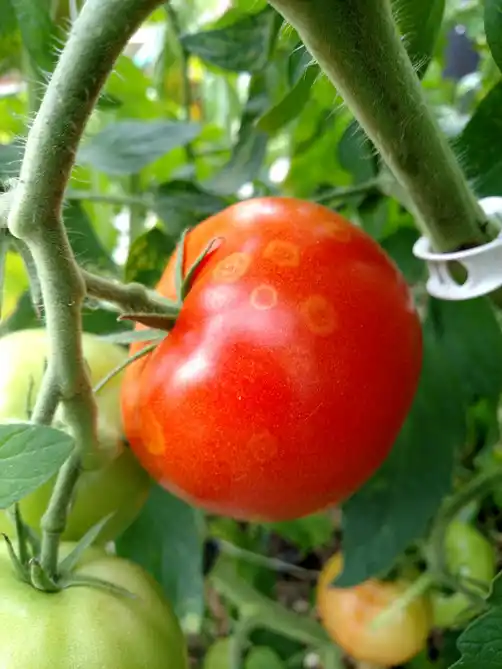Who doesn’t want to keep their tomato plant free of diseases? But they are very delicate plants and may catch serious disease and pests even if you neglect to care even a little.
First, you must be proactive, so your healthy plants don’t catch any disease. You need to keep a close look at your tomato plant to identify the disease, if any, at the initial stage only. Your tomato plant may struggle with a physiological disorder due to different types of Viruses and pathogens.
You can choose a disease-resistant variety of tomatoes, identify and remove the leaves with signs of disease, do not stress the plant while tomato foliage is wet, keep a good airflow facility and mulch them properly.
Types of Common Tomato Plant Diseases With Pictures
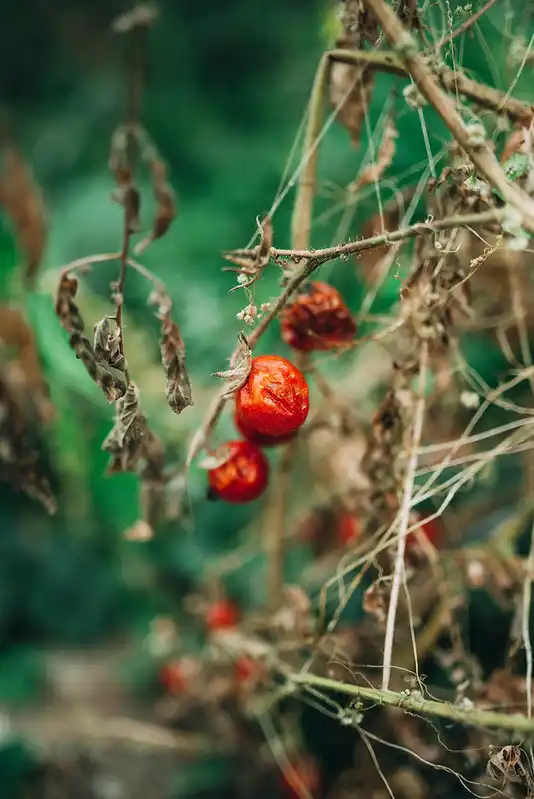
Tomato plants can get infected by various pathogens, which can cause vital diseases, and some of the diseases even kill the plants.
I have explained some of the diseases in this article caused by different types of pathogens.
So firstly, it is better to discuss different types of pathogens and their preventive measures to keep your garden safe from their attack.
There are several viral, fungal and bacterial pathogens that cause tomato diseases. Their spreading rate varies on the wind, temperature, water stress, disease resistance capacity of your tomato plant, the health of your plant, and many more.
If you diligently care for and keep your plant healthy, they become more resistant to disease.
Tomato Plant Diseases Caused by Fungal Pathogens
Fungal pathogens are a great threat to tomato plants and they can damage all the parts of the tomato plant, including its flowers and fruits.
Alternaria Stem Canker
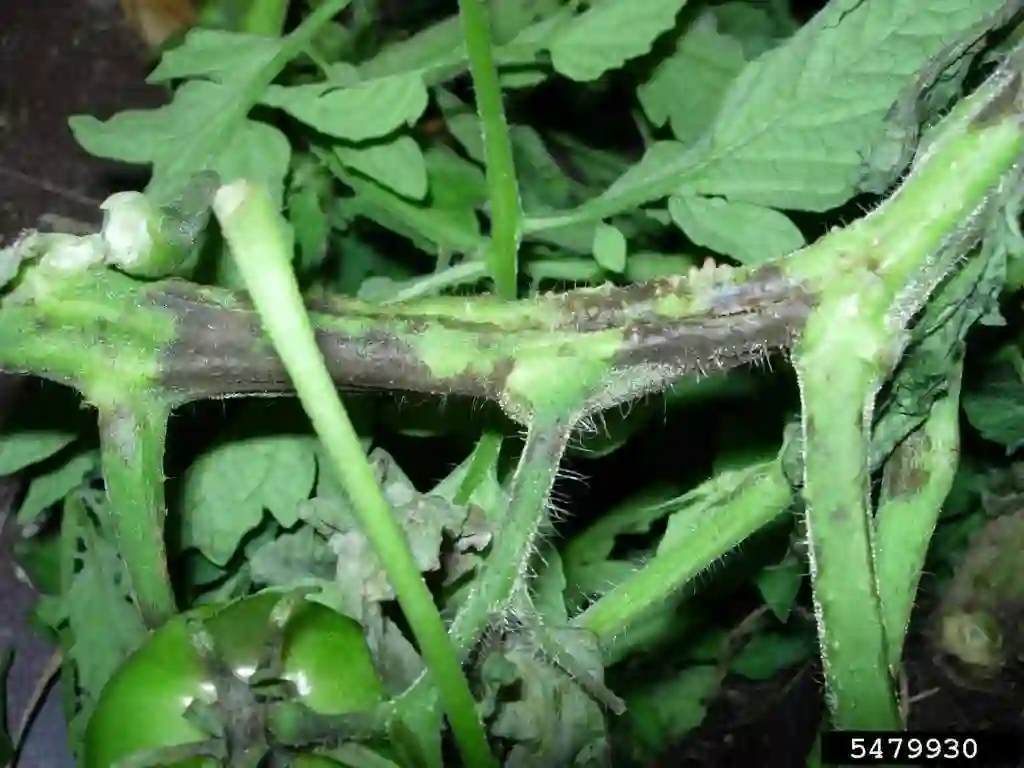
Alternaria Stem Canker, as the name suggests, attacks the stems of tomato plants, but it also damages the leaves and fruits of the plants. It is similar to the disease which spreads early blight in tomatoes.
The cankers are developed on stem, fruit, and leaves and turn their color dark brown and sometimes black. This happens as the toxin produced damages the tissue between the leaf veins. They are developed on the stem near the soil line or aboveground.
Alternaria Stem Canker often develops concentric rings on green fruit.
When airborne spores come in contact with tomato plants or when the soil reaches the plant, Alternaria Stem Canker is spread in the tomato plants.
The plant is impacted due to this disease in excessive heat, especially when the temperature is above 77F.
Avoid overhead watering; instead, ensure to water in the soil line; use a soaker hose or Drip irrigation to water your tomato plants.
Watering the tomato plant at night keeps the plant healthy as the risk of overmoisture in the soil is reduced.
Resistant varieties of the disease are Phoenix & Mariana. Though these plants can also get impacted due to the disease, it would be the first step towards a good start for your plantation.
Using chlorothalonil as a fungicide before 4-6 weeks of your expected harvest can protect your tomato plant from the disease.
Other fungicides might be needed if your harvest is maturing in the fall.
Anthracnose
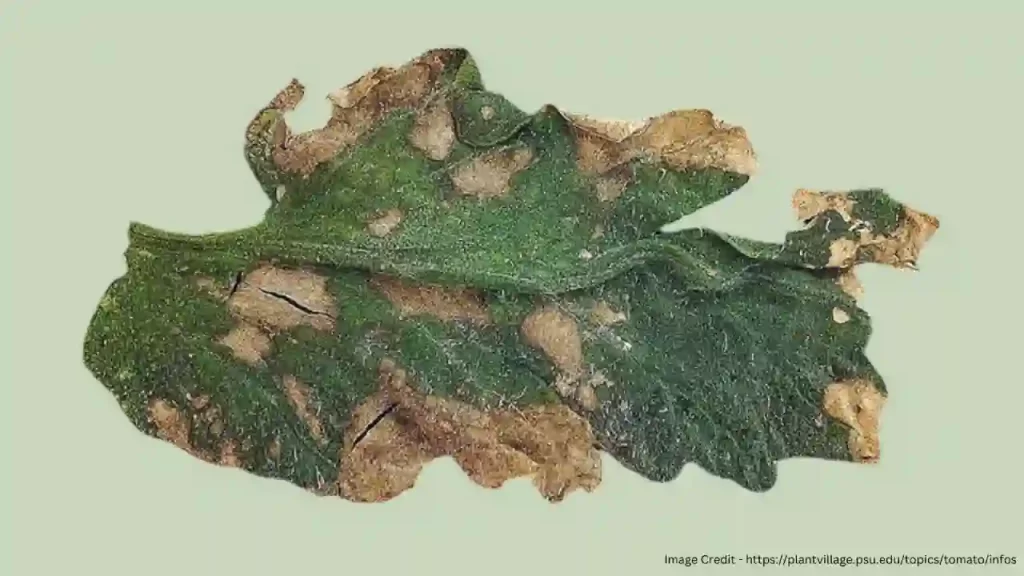
Anthracnose disease is a curse for varieties of plants that directly attack their leaves, fruits, and flowers, and in the case of tomato plants, matured tomatoes or over-ripened tomatoes are impacted.
Anthracnose is caused by Colletotrichum coccodes and spreads in the lower part of the leaves, which are infected by early blight. Later, spores are developed on the tomatoes.
The disease is spread in immature and green tomatoes, and the impact is traceable when the tomatoes are ripened. Slightly sunken, small ring spots are developed on the tomatoes. These ring spots expand to half an inch and form concentric rings. The lesions seem like blacky patches.
The lesions become vigorous during moist weather, and many spores are formed in the lesions.
Tomato plant Root rot due to Anthracnose is called black dot root rot.
The tomato plants become more prone to disease when they are wet. Avoid overhead irrigation, especially when the tomatoes are maturing and ripening.
Crop rotation each year is the best way to prevent the disease. Facilitate your plant with a good drainage system to avoid the risk of this disease.
The fungicides depend on the climatic conditions of the region where you are located. Fungicides are not needed in dried climatic conditions, whereas in humid climatic conditions areas like New York, fungicides are recommended to be applied.
Black Mold
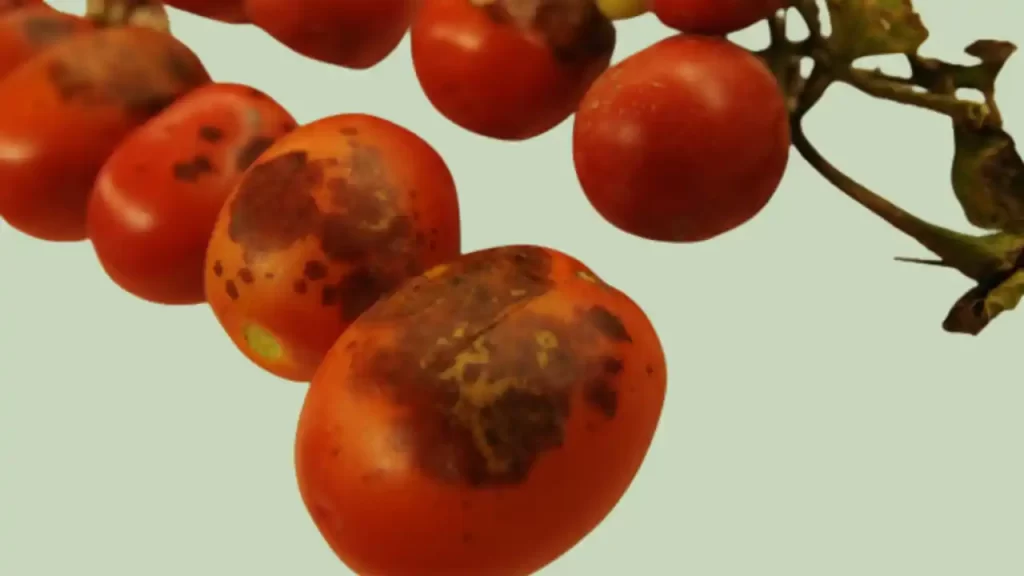
Ripened tomatoes are prone to Black Mold disease, which becomes active in late-season rainfall. It is caused by Alternaria alternata.
The symptoms are seen as light to dark brown lesions on the ripe tomato’s surface, vary from small to large in size, and destroy the epidermal tissue of the tomatoes in circular sunken lesions and spread deep into the fruit.
The lesions formed are like black velvet on the surface of the tomatoes. The fungus encourages forming wounds at the sunburned surface of the fruit.
If you find the spread of this fungal diseases in your garden, harvest the tomatoes as and when they are ripened and stop overhead irrigation.
Fungicide application is needed in heavy rainfall and for a late harvest of tomatoes. As discussed above, you can use the same fungicide used to treat Alternaria Stem Canker.
Botrytis Gray Mold
Botrytis Gray Mold is caused by one of the most vigorous pathogens, which can destroy more than 200 varieties of plants, vegetables, fruits, and ornamental plants.
It is caused by Botrytis cinerea and causes postharvest decomposition of tomatoes.
It infects all parts of the tomato plants, like flowers, fruits, stems, and leaves, and is a matter of concern in the greenhouse.
The wind spreads the spores caused by the fungus. When the plant is moist due to rain, fog, or irrigation, Botrytis Gray attacks the plant.
The fungus can infect immature and green tomatoes, form white ring spots, and the color turns yellow when the tomato ripens.
Maintaining a good airflow system, disinfecting the gardening tools, and avoiding overhead irrigation habits are the best measures to prevent your tomato plants from Botrytis Gray Mold.
It is best to check for fungicides with your country’s extension person to determine the effective fungicide for your area if you want to use them.
Early Blight
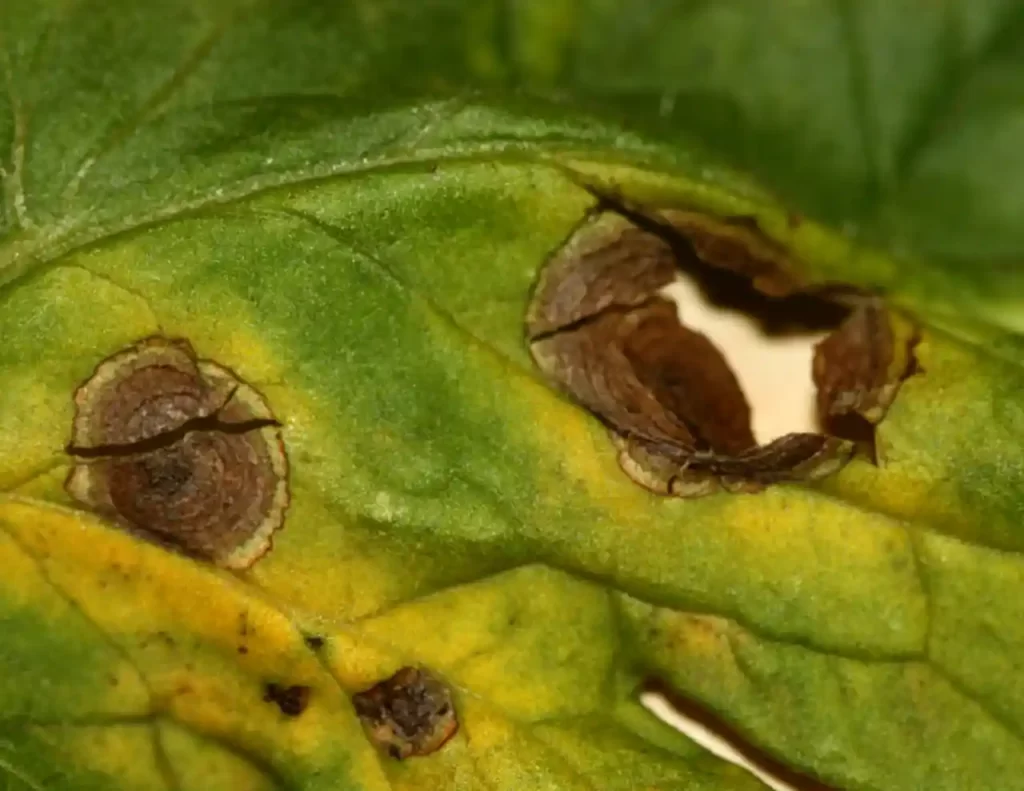
Joey Williamson, ©2012 HGIC, Clemson Extension
Alternaria solani promotes Early Blight. Tomato leaves, stems, and fruits are mainly impacted, and small brown and black spots are formed in classic concentric rings.
Your tomato plant becomes more prone to get infected with Early blight, especially during rainy weather. The spores are spread when the plant is wet and even spread by wind.
Early blight resists tissues from infected tomatoes, nightshade weeds, and potatoes. It is better to destroy the infected plants and discard them.
Please do not use them as compost, as the fungus may spread in your garden and simply destroy the harvest.
The fungus can sometimes vanish in dry weather conditions. You can also use fungicides chlorothalonil and fenamidone to control the disease.
Fusarium Wilt
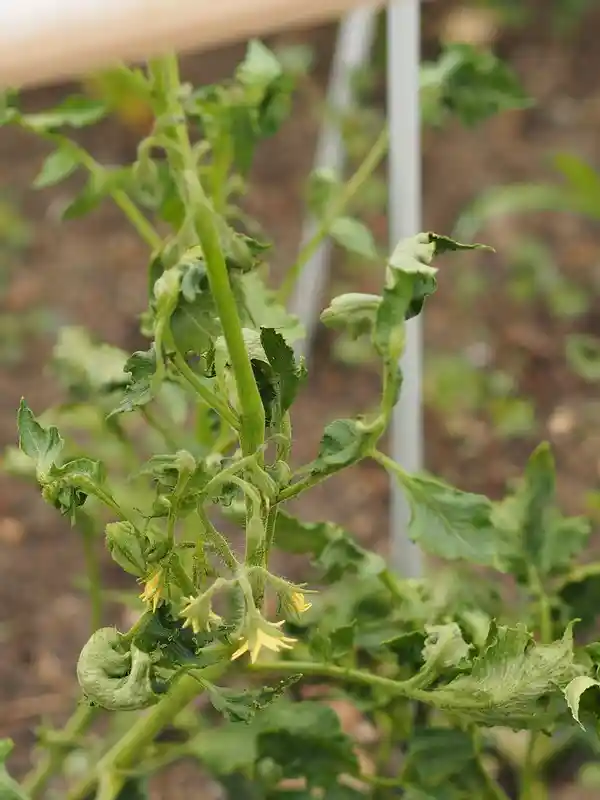
Fusarium Wilt is spread by the fungus Fusarium oxysporum f. sp. Lycopersici. It causes wilt in the tomato plants, and the fungus survives in the soil for several years.
The affected leaves turn yellow and wilt. The impact of the Fusarium Wilt is seen only on one side of the plant, denoted as the “Yellow Flag Effect.” The impacted plant is totally destroyed.
Wilts caused by Fusarium and Verticillium are almost similar. So gardeners often need clarification to confirm the type of wilt. It can only be confirmed with a lab diagnostic.
It is best to plant Beefmaster and Better Boy as they are resistant to Fusarium Wilt. But other pathogens can impact these varieties of tomato plants. So it is always safe to choose the variety resistant to your area.
Fusarium Crown and Root Rot

Fusarium oxysporum f. sp. Radicis-lycopersici is the main cause of the Fusarium Crown and Root Rot. It stays in the soil for so many years.
Bad soil drainage facilities and cooler temperatures between 50 -70F result in the spread of infections—in various crops and weeds, including tomato plants. Pepper and eggplants can be destroyed due to the infection.
The infections affect the oldest leaves and turn the color of the leaves, including their margin, to yellow. You can also notice discoloration and lesions of dead tissues in the stem. This infection is enough to destroy the roots of the plant and results in the death of the plant.
Fusarium Crown and root rot cause stunted seedlings, root rot, wilting, and discoloration of the stem, ultimately killing the plant.
Rarely is there any treatment for the disease? It is better to plant a resistant variety to the disease. You can refer to the listed varieties on Cornell University Vegetable Website. For planting tomatoes in greenhouses, sterilize the soil before planting.
Pull the infected plant from the roots and dispose of them. Do not use them as compost in your garden to reduce the risk of spreading the infection.
Powdery Mildew
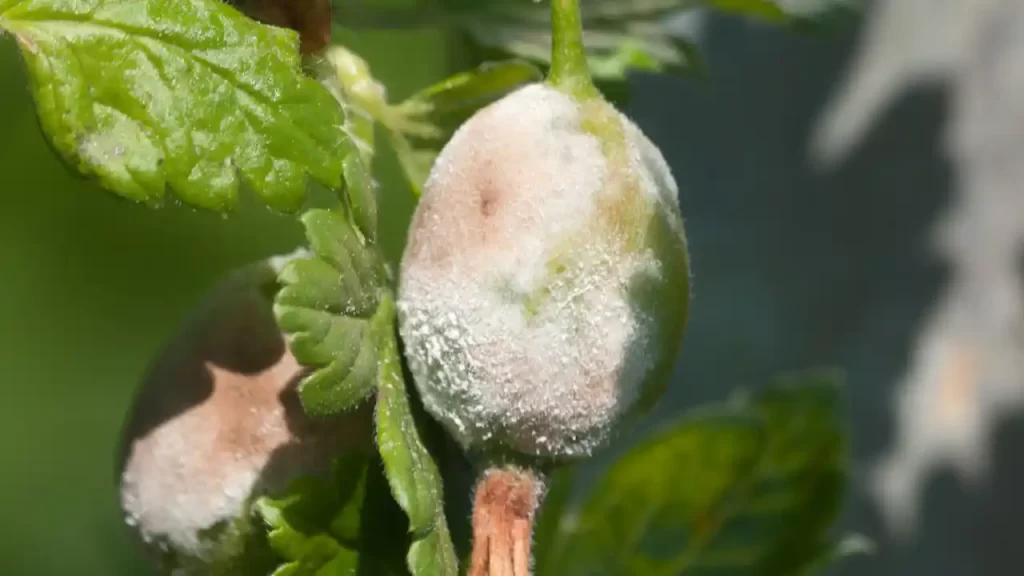
Powdery Mildew forms spores on the leaves of the tomato plants, which seem like white powder on the upper and lower parts of the leaves.
Oidium neolycopersici causes Powdery Mildew which mainly impacts leaves. It turns the leaf color yellow, making it dry and causing necrosis and defoliation.
Dead tissues on the lower and old leaves are also found. They do not infect stems and fruits, but 50% of the crop can be destroyed due to the fungus.
Solanaceae family crops and weeds like tomato, potato, pepper, and eggplants are infected due to the fungus. The ideal temperature for the infection is 60-77F, and a humid climate also encourages powdery Mildew.
Planting resistant varieties like ‘Geronimo F1’, ‘Granadero F1’, ‘Massada F1, and ‘Striped Stuffer’ can reduce the disease risk. The use of fungicides, neem oil, and Bacillus pumilus can help to prevent the disease.
Septoria Leaf Spot
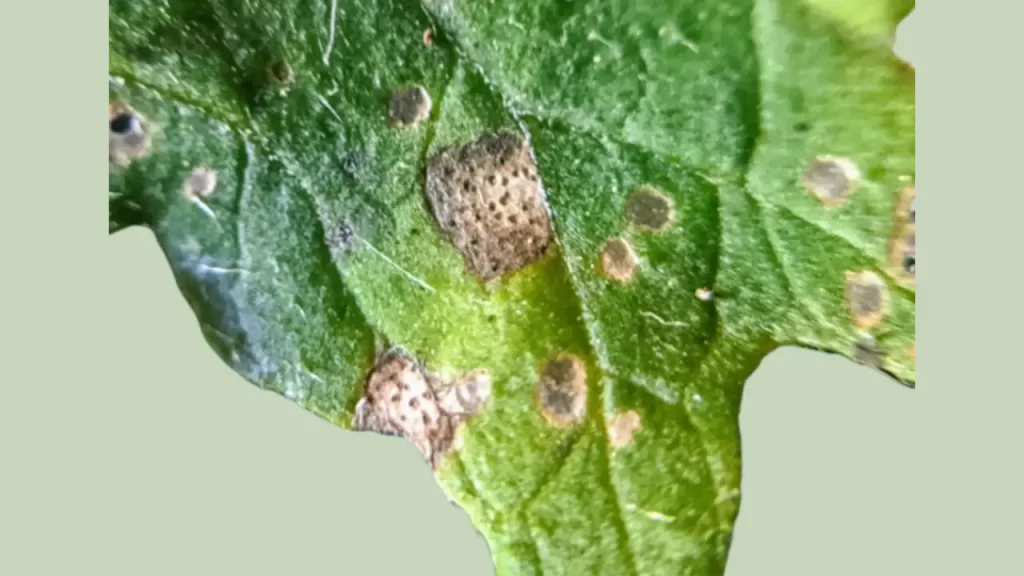
Septoria lycopersici causes Septoria Leaf Spots, also known as Leaf Canckers. It infects tomatoes and other Solanaceae families like potatoes, pepper, and eggplants.
The disease can infect plants at any stage of their development. But mainly older leaves are impacted when the plant is setting fruits on it. Small circular water-soaked spots are formed on the older leaves.
After some time, the spots enlarge and coalesce. The disease forms pimple-like structures which are dark brown in color called pycnidia. This helps to distinguish the Septoria leaf spot from Early Blight.
The spores of the infection are spread in the rain, wind, insects, and gardening tools. Always clean and disinfect your gardening tools before and after use.
The spores can stay on the debris of the infected plants. Always clean your garden at the end of the season and discard all the infected plant debris thoroughly to reduce the risk of disease spread.
Remove the infected leaves and dispose of them, maintain good airflow, and keep proper mulching. The application of fungicides helps prevent infection.
Southern Blight

Southern blight is caused due to Sclerotium rolfsii fungus. Due to its resting structure, it can stay in the soil for longer. The ideal temperature for the disease is above 85F.
Lesions on the steam or near the soil line are formed, which develops lesions and results in wilting of the plants and spreads rapidly.
Mycelia white mats are developed on the stem and in the adjacent soil.
Rotation to non-host crops like corn, sorghum, rice, or small grains for a couple of years helps to prevent the disease.
Pull and destroy the infected plants and do not use them as compost. Simply burn and discard the infected plants.
Keep the soil surface dry to reduce the risk of spreading the disease.
Verticillium Wilt

The disease is caused by Verticillium dahlia and V. albo-atrum.
There is hardly any treatment for the disease as it survives in the soil because of its resting structure and can infect many plants and crops.
The infection turns the color of the leaf to yellow in its V shape, then turns brown, and finally results in the death of the leaf, which leads to sunscald on the tomatoes.
The production of fruits is mainly impacted due to the disease, but the plant may not die.
It is very difficult to differentiate between the Verticillium and Fusarium wilt. Only a lab test can tell the difference.
Ensure to clean and disinfect the gardening equipment and tools between the pants and rotating crops to avoid spreading infection.
Maintain a good drainage facility of the soil, and plant the resistant varieties of the tomatoes with VF indication in the plant description. It is resistant to both Verticillium and Fusarium wilt.
White Mold (Timber Rot)
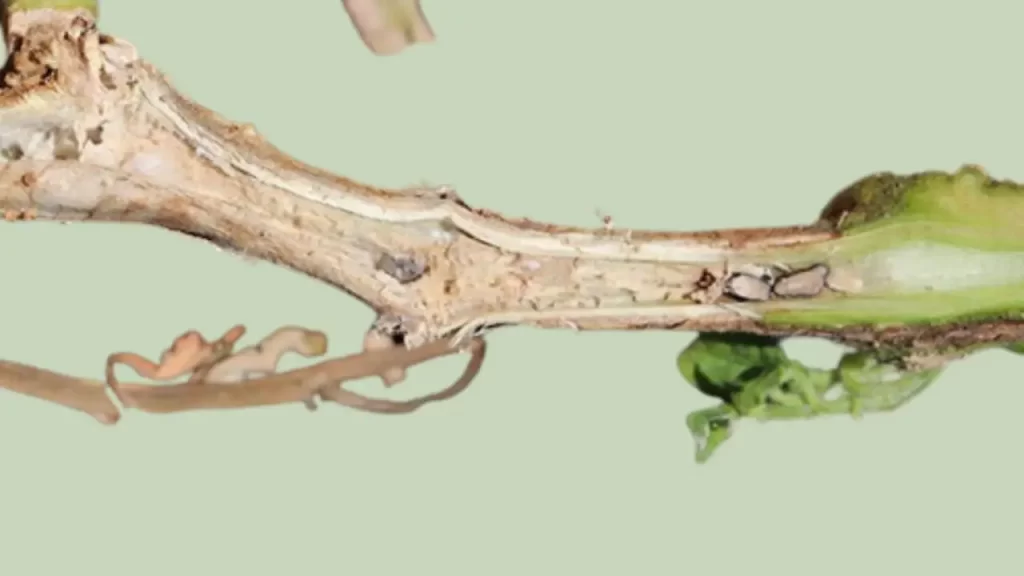
Sclerotinia causes White Mold, an uncommon but very severe disease for tomato plants and affects rotten flowers falling on the plant’s stem.
This disease is also known as Timber rot, as water-soaked lesions are developed on the stems that dry out and appear bleached.
It possesses a resting structure, due to which it can survive in the soil for many years. The spores of the disease are formed in cooler climates and spread mainly by wind.
Ensure maintaining limited soil moisture by using drip irrigation. The spores of the fungus are less likely to develop in dry soil.
Tomato Diseases Caused by Water Molds
Water Mold is a type of fungi as well as Oomycetes. They possess destructive pathogens dangerous to tomato plants.
Late Blight
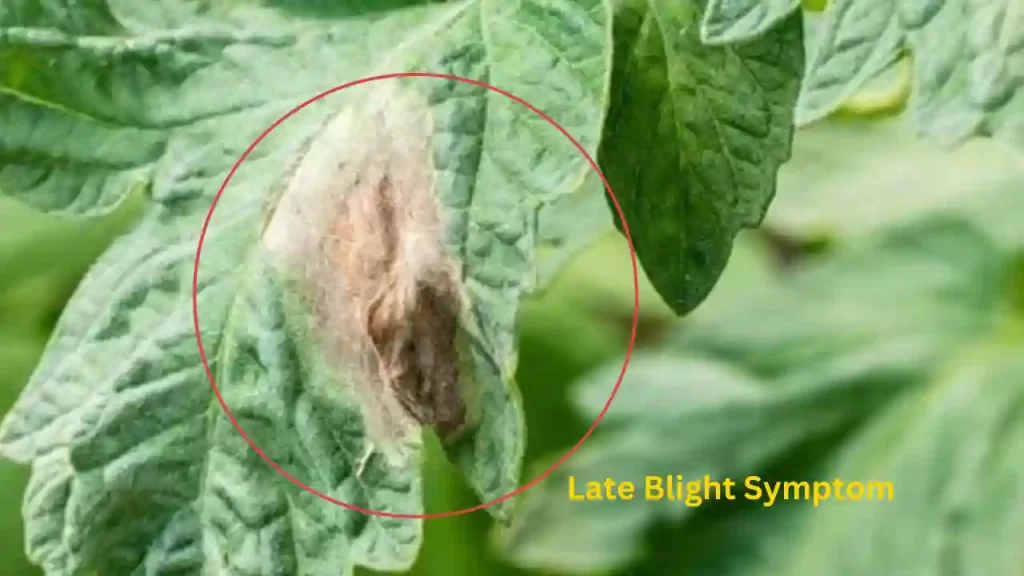
Phytophthora infestans cause Late blight in tomatoes and potatoes. It is a very dangerous pathogen that resulted in Irish potato famine. Millions of people were killed due to the infection.
The ideal temperature for the occurrence of the disease is 60-78F. It can occur in 10 hours in a high-humidity climate.
Older foliage develops small oily dark purple spots which are round and brown and can increase up to half an inch in diameter. Large spots are more prone to forming concentric rings. Water-soaked leaves are the targeted leaves.
It results in the death of the leaves and the spread of the disease in new young stems.
The upper surface of the fruit is infected as the spores are spread from the upper side and the color of the fruit is turned to brown.
It is a highly contagious disease that can spread not only to its neighboring plants but also to its neighboring gardens.
They can survive in the debris of tomatoes: potatoes, and some other nightshade plants.
Pull the infected plants and burn or dispose of them. Also, ensure to remove the neighboring plants even if it is not show any symptoms.
Ensure not to use the infected plants as compost to reduce the risk of spreading the disease.
Phytophthora Root Rot/Buckeye
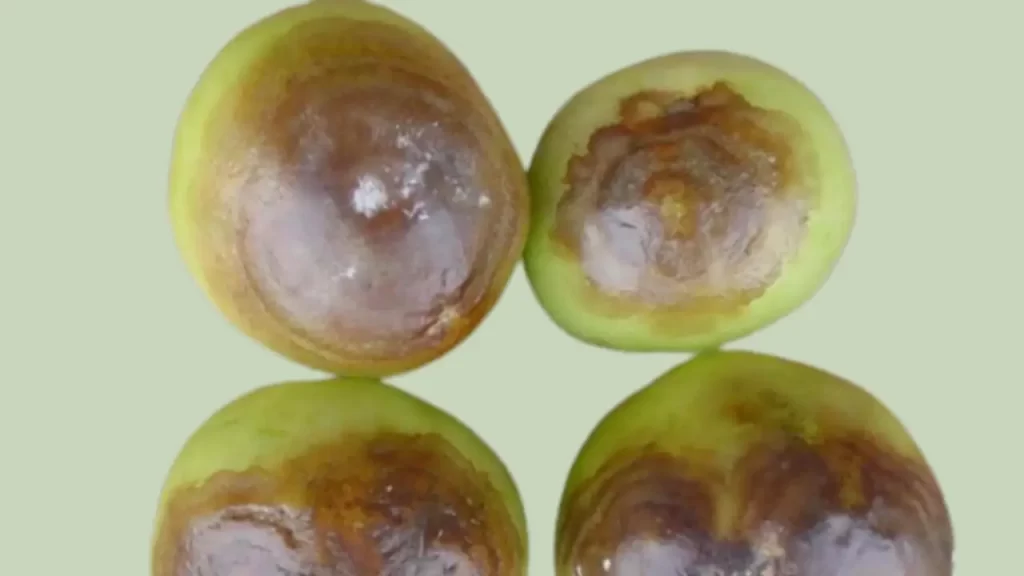
Phytophthora parasitica and P. capsici cause Phytophthora Root Rot/Buckeye. They infect the plant at the stage of development when the soil is excessively moist.
The disease is spread in hot climates. Wilting and root rot of the plants is the main symptom of Phytophthora Root Rot/Buckeye. Damping off in the seedling stage can also be experienced.
Keeping the soil moist in the right amount and consistent water supply to the plant can prevent the spread of infection.
Also, maintain a good drainage system of the soil to keep your plant stay away from infection.
Brown spots with lathery tan are formed, which is called buckeye rot.
Application of fungicides and crop rotation with cereals can help reduce the disease risk.
Diseases Caused by Bacterial Pathogens
Bacterial Pathogens mainly attack outside-grown and greenhouse-grown tomato plants. The bacteria are multiplied through infected seeds and transplants and spread through water, insects, and gardening equipment.
To reduce the risk of the spread of the disease, clean the gardening tools and equipment regularly and keep your garden insect free.
Bacterial Canker
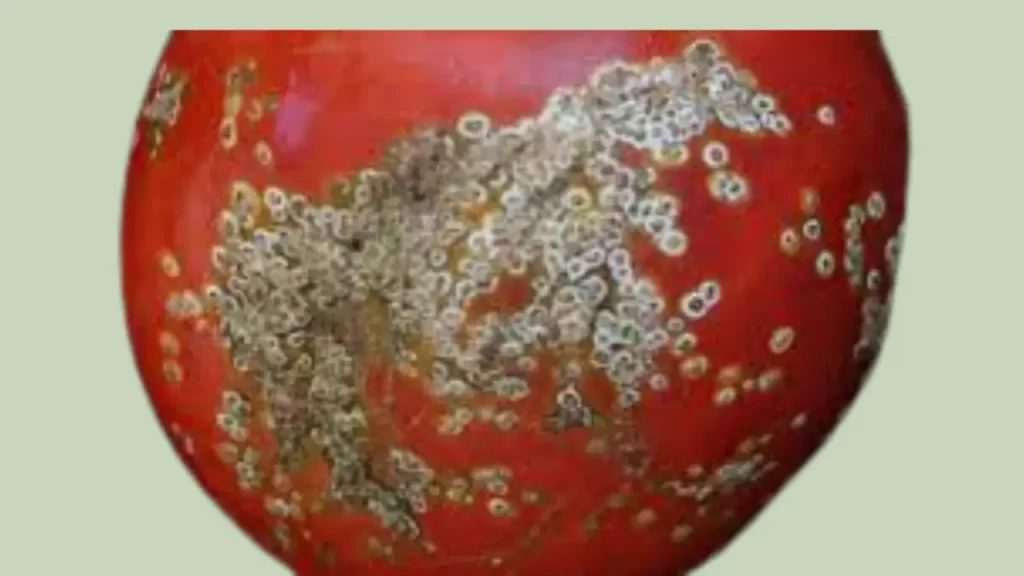
Clavibacter michagensis subsp. Michiganesis causes Bacterial Canker and mainly attracts greenhouse plants and destroys the crops drastically.
It impacts tomato plants’ home gardens and commercial fields, especially during wet weather.
Sometimes the seeds from infected fruits are used for transplanting the tomatoes. Obviously, it would result in an infected plant.
Sometimes certified disease-free seeds can possess the bacteria, or infections are spread to the seedlings even after germination.
Two types of infections are there. The primary one is a systemic infection that badly impacts the plant.
Wilting in the plants can be seen, and the development of plants is also stopped. It prevents new growth in the oldest branch of the plant first.
The leaves start curling, then become yellow, wilt, turn brown again, and finally collapse. Sometimes green stripes on the stem are visible, which later turn brown.
In secondary infection, the root, stem, and fruits are infected. Due to this, spots on leaves and fruits are developed, also called “Birds Eye Spots.” These spots later turn into lesions.
Wet weather and gardening in damp situations attack Bacteria Cankers.
There is hardly any treatment for the infection; it is better not to plant the infected seeds. This would prevent Bacterial Cankers from occurring in your garden.
Properly sanitize the gardening tool and disinfect the greenhouses if previously impacted by the disease around ten months. You can apply bactericides in infected plants during wet weather.
The use of Copper might be helpful in secondary infection but does not show any benefits for systemic infections.
This bacteria can easily stay in tomato debris, but if it decomposes in the soil, it can never survive and get destroyed. But decomposition of all the infected plants in the soil is not that easy. So avoid planting in the same garden for at least a year.
Bacterial Speck

Bacteria Speck arises in cold weather and gets destroyed when the temperature rises 75F.
Pseudomonas syringae pv. Tomato is the bacteria that causes Bacterial specks. And it can resist the soil because of its resting structure.
The disease can stay in the debris of dead plants and on the surface of seeds.
The infection impacts tomato fruit, leaves, and stems and forms dark brown and black lesions, and its outline looks yellow halo.
Avoid overhead irrigation and use drip irrigation methods and soaker hoses for consistently watering your tomato plants. The copper spray helps to reduce the infection in the plants.
Rotation of unsusceptible crops like corn helps prevent the disease for a couple of years. The plantation is recommended in the spring when the weather warms up.
Consult your local extension office to find out the effective fungicide in your area, as some races of bacteria are now resistant to copper spray.
Bacterial Spot

Xanthomonas campestris pv. vesicatoria bacteria causes Bacterial Spots in tomato plants. It attacks mature plants and seedlings.
It is very difficult to distinguish between Bacterial Spots and specks. Only lab tests can diagnose the disease.
It continues from one season to the next season and survives in dead tissues and debris.
The infection spreads from seeds, and it is very tough to control if spread in the garden or field. Leaves of infected plants are shaded. And it mainly attacks the water-soaked leaves. You can spot spots on leaf margins because of the disease.
Cultural controls and copper spray can help to reduce the spread of Bacterial spots in tomato plants.
You should avoid overhead irrigation and use soaker hoses to irrigate the plants. Always choose disease-free certified seeds for planting tomatoes.
Rotate your crop with corn to prevent the subsequent disease with corn as it belongs to the Solanaceae family.
Diseases in Tomato Plants Caused by Phytoplasma
Phytoplasmas are parasitic and act like viruses, and are smaller than bacteria. They can only exist in live hosts.
Tomato Big Bud
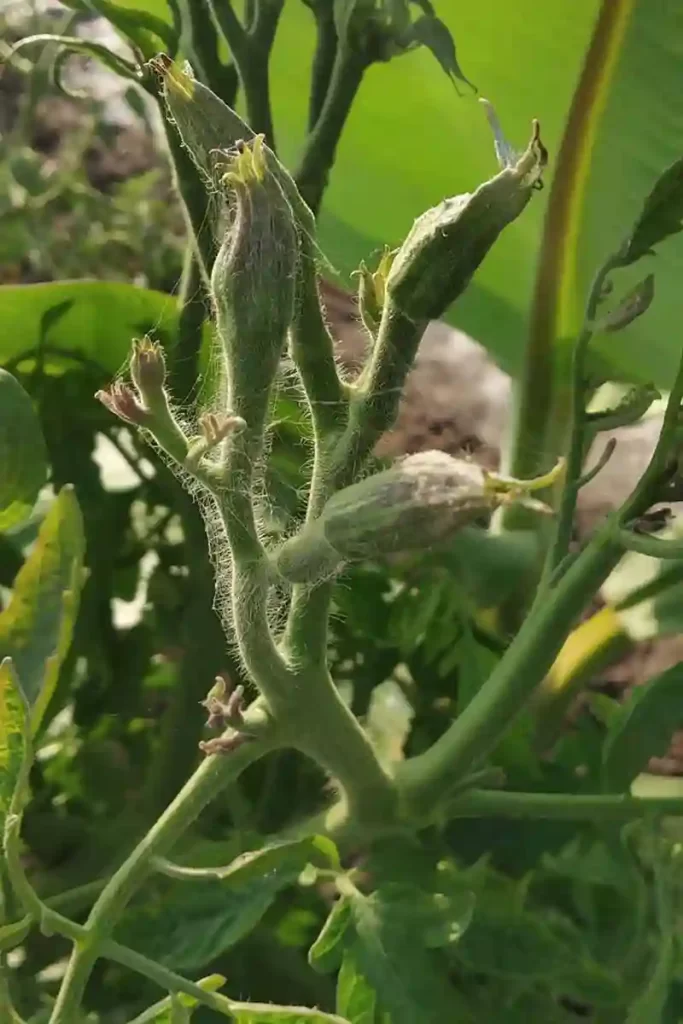
The beet leafhopper causes Tomato Big Bud. The infected plant has large, swollen green buds that cannot form fruit. The plant appears to be bushy with small yellow-green leaves.
The Beet Leafhoppers in your garden can stress your tomato plant, reduce their capacity to produce fruit and impact their development.
Using insecticides and attracting insects like butterflies and native bees can prevent Bett Leafhoppers from existing in your garden.
Tomato Plants Diseases Caused by Viral Pathogens
Many viruses affected plants brutally damage and result in discoloration of leaves, leading to underdevelopment or slow development of tomato plants and making them inefficient in producing quality fruits.
Insects spread the disease to the tomato plants. Thus it is very important to keep your garden insect free.
Alfalfa Mosaic Virus
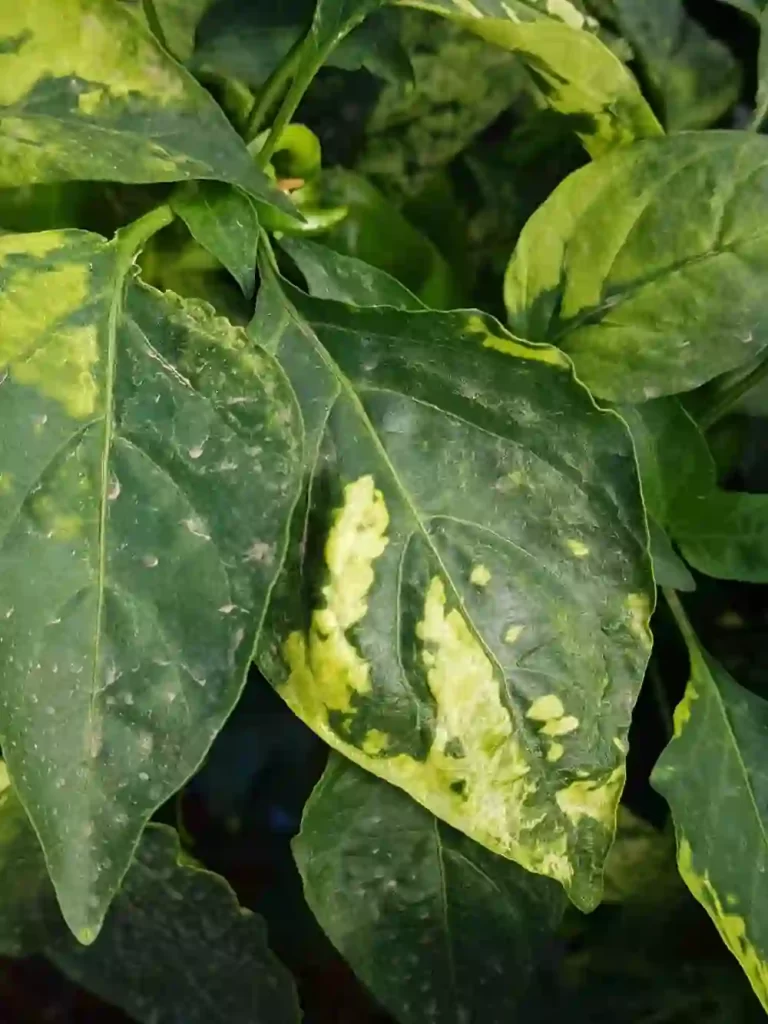
Never plant your tomato plant near Alfalfa as the plant is more prone to get Alfalfa Mosaic Virus.
In the USA, so many Alfalfa fields are impacted by Alfalfa Mosaic Virus and are contagious. So they easily get spread to the neighboring plants.
The affected plant’s leaves molt, and their color changes to yellow. Dead tissues in a circle shape are formed on the tomatoes. The plant becomes incapable of delivering nutrients as the phloem is also destroyed and turns brown.
Alfalfa Mosaic Virus can not be treated or controlled even with insecticides or chemicals. Prevention can only save your tomato plants from Alfalfa Mosaic Virus; it is better not to plant your tomato near Alfalfa.
While planting, use silver reflective polythene as a mulch to protect your plant from Alfalfa Mosaic Virus.
If any plant is already infected, it is better to discard the plant to protect other plants from spreading the disease.
Tobacco Mosaic Virus
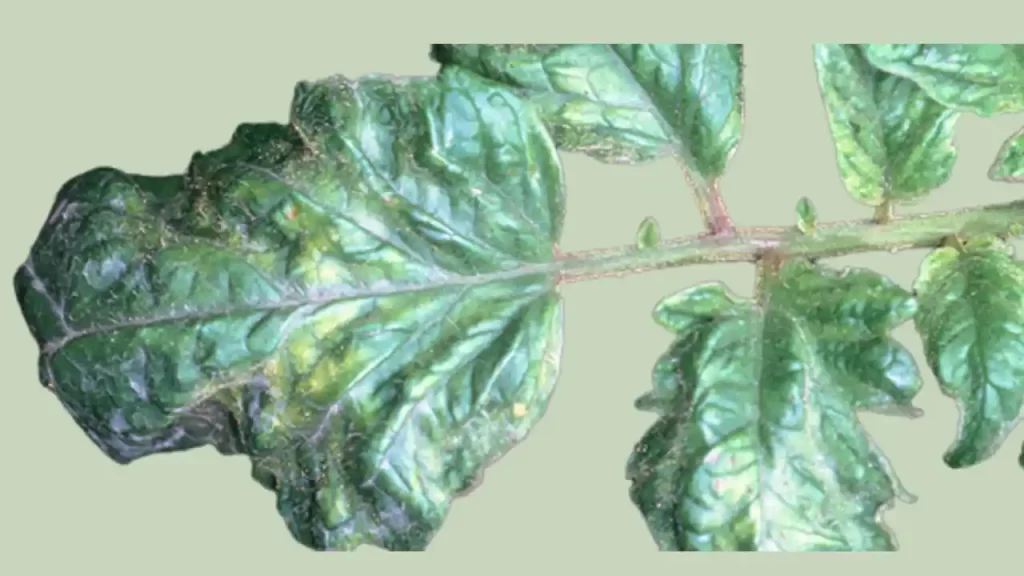
Tobacco Mosaic Virus is consistent in nature. They can exist for around 100 years in dried plant debris. It infests tomato plants and damages gardens, files, and greenhouses, and they can also spread from tobacco.
The TMV-infected tomato plants look stunted, leaves develop a mosaic pattern of yellow and light or dark green, and leaves have malformation and leave yellow spotting. The disease is commonly seen in young plants and fresh tomatoes available in the market.
Avoid using the infected plant as compost, as you can easily spread the disease to the rest of the plants.
Maintain proper hygiene while gardening. Disinfect all your gardening tools. Bring the disease-resistant variety seeds like “Geronimo” and “Arbason” to ensure preventive measures against TMV diseases.
Tomato Spotted Wilt Virus
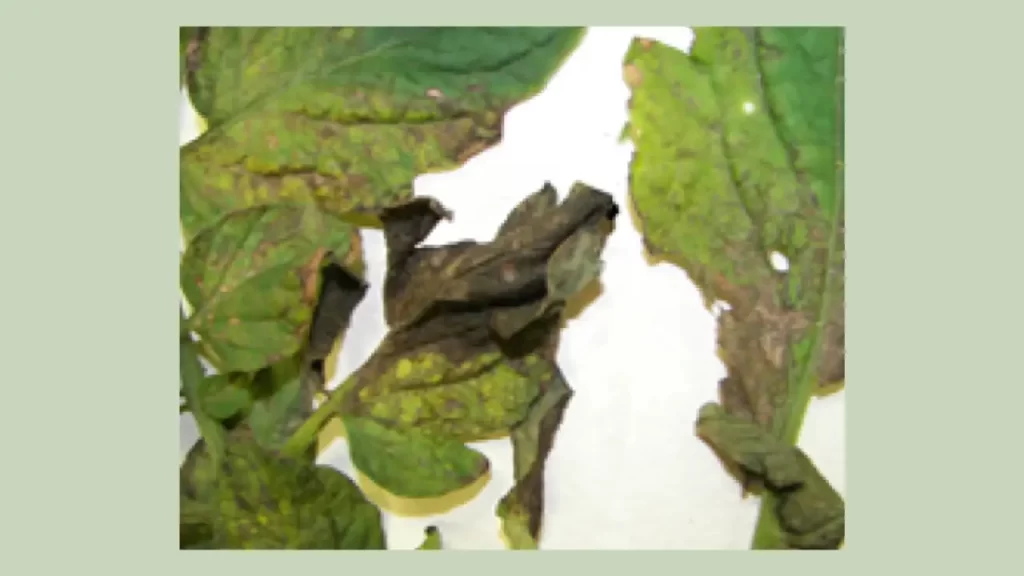
Tomato Spotted Wilt Virus is a very uncommon type of Virus in plants as TSWV is also spread to ornaments.
Only in tropical areas, this disease is traced, but it is alarming the world now. Mainly new leaves are impacted due to TSWV and turn their color to brown with some dead tissue spots on them. The affected tomatoes develop ring-yellow spots on them, but you can trim the affected areas and use them normally.
The Virus is spread by insects called thrips, such as flowers, onion, and chili thrips. Infected plants should be removed immediately from the garden to reduce the risk of spreading the disease to the neighboring plants.
Keep your garden sanitized, weed free and use reflective mulches as a prevention of the disease.
Summerpick and Quincy can be planted as they can resist the disease.
Tomato Plants Diseases Due To Physiological Disorders
Gardeners often make mistakes in identifying the physiological disorder of tomato plants and infections in the plants.
Changes in Environmental conditions like climate change, changes in climate, pollution, poor care of plants, and poor watering techniques lead to physiological disorders in the plants.
Blossom End Rot
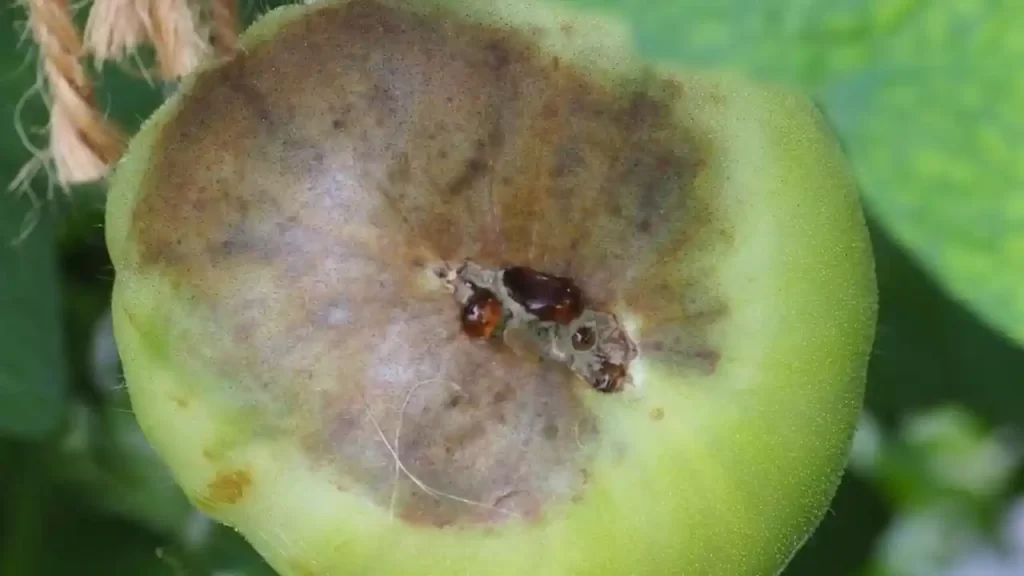
The first tomatoes of the season are more prone to Blossom End Rot. The Main reason behind Blossom End of Tomatoes is calcium deficiency in the plant.
Even if you have planted the tomatoes in the most fertile soil, BER can happen in the tomato plants. It mainly happens because of improper moisture.
Blossom End Rot usually happens in drought conditions and produces lesions forming concentric rings on the surface of tomatoes.
You can prevent it by providing proper support to the plant before the roots of the plants are developed.
Also, do not walk or cultivate in nearby areas of the tomato plants. This would help not to stress the root system.
Mulching can maintain adequate moisture in the soil, and drip irrigation and soaker hoses can also ensure the adequate water supply in the correct way.
Catfacing
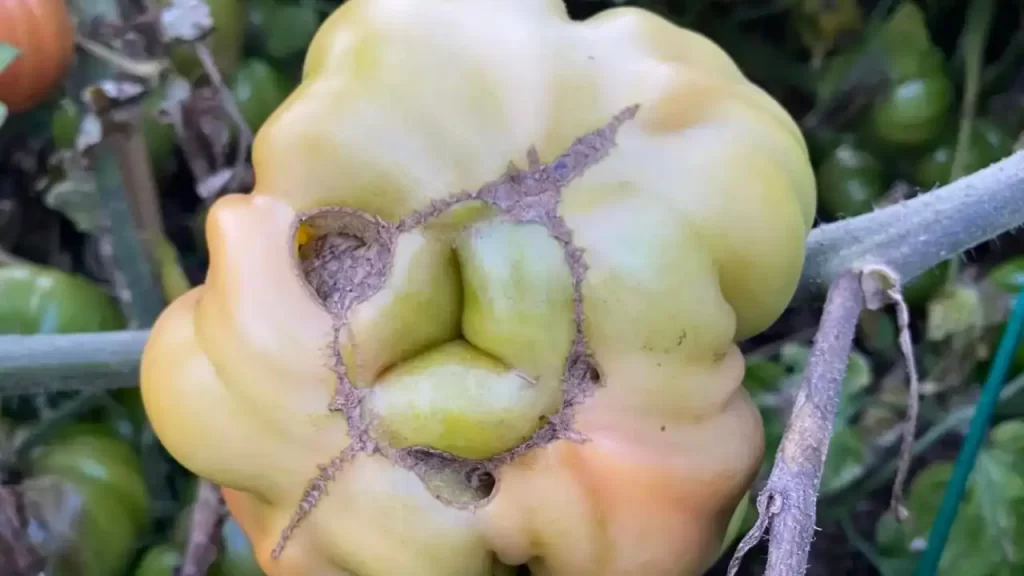
When tomatoes form puckered surfaces and distorted shapes with brown line-type scars, it is the symptom of a cat facing disorder. The disorder can be minor or large.
This disorder is common in large-sized tomatoes and the earliest harvest of the season.
The disorder happens when flowers are unnecessarily stressed while blooming, sudden cold or hot temperatures shock, and too much nitrogen content in the soil.
If your tomatoes are facing this disorder in every crop season, choose the resistant varieties of tomatoes like Countil, Duke, and Walter.
You can easily prevent the disorder by watering your tomatoes in the right amount and in the right way, not using excessive fertilizers, and stop pruning.
Fruit Cracking
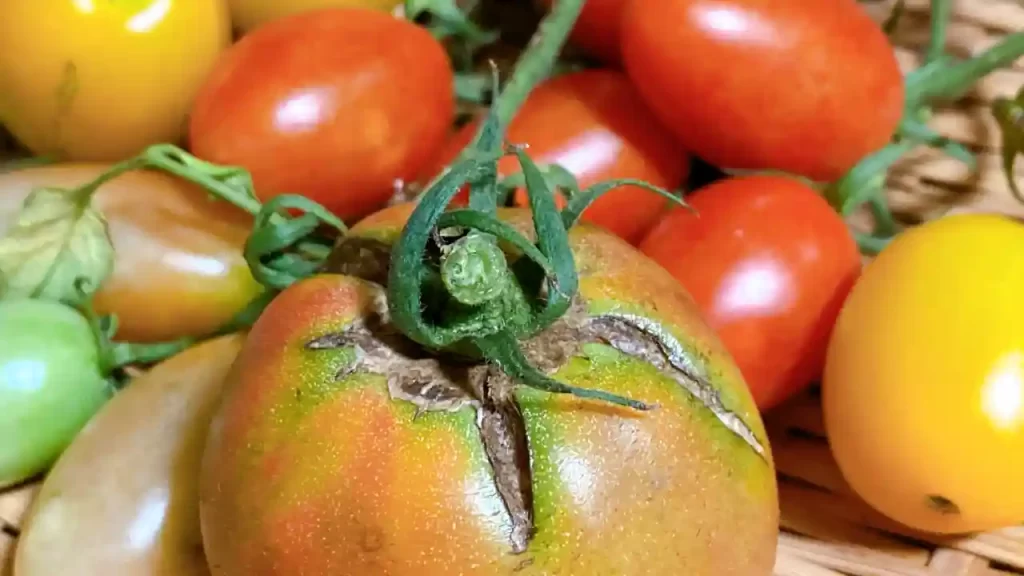
Fruit cracking and catfacing look very similar to each other. But both disorders happen because of different reasons.
Suddenly, when plenty of water is delivered to the plant, the developing and developed fruits crack.
This happens due to heavy rainfall or overwatering in the plant. The roots deliver too much water to the plant and the flesh of the fruits swells. As a result, the skin of tomatoes is cracked.
Growing resistant varieties like Marglobe and Daybreak can prevent the disorder.
Consistent water supply to the tomato plants and maintaining proper soil drainage facility by mulching can prevent the fruits from cracking.
Preventing Tomato Plant Disease and Saving Infected Plants
It is well said that prevention is better than cure. I always take preventive measures to make sure my tomato plants won’t catch any disease.
The below tips can help you prevent diseases in your plant:
- Do not plant your tomatoes in the same place each season. Keep rotating your crop and this helps to save them from different pathogens already present in the soil.
- If you have traced any infected leaves in your tomato plant, pin them off and discard them immediately. This prevents the spreading of infections.
- Avoid working in the garden while the tomato foliage is wet; otherwise, it would spread pathogens from one plant to another.
- Choose the variety of tomatoes that are more resistant to diseases at the time of seeding your tomatoes.
- Dispose of all the diseased tomato plants and do not use them as compost to prevent the spreading of disease in your uninfected tomato plants.
- When you plant to keep the same tomato plant for the next season, ensure that the plant is free from any disease.
- Maintain around 18-24 inches of spacing between each plant to maintain good airflow.
- Mulching your tomato plants keeps the soil moist adequately. You can use leaf mold, compost, or straw to prevent soil fungus during excessive rain.
- Keep tomato plant foliage dry. You should avoid overhead irrigation; instead, you should use hand irrigation or Soaker hoses to water the tomato plants, and water directly reaches the root of the plant. Thus wet foliage is not experienced by the plants and the risk of the fungus spread is also reduced.
- If you are growing tomatoes in pots or containers, disinfecting and cleaning the pots is a very important step.
Final Thoughts
Various types of tomato diseases can destroy the entire plant. It is very important to take preventive measures before and during the plantation process so that your tomatoes never get attacked by any disease. Research which disease is common in your area and choose the resistant variety of tomatoes to plant them.
Many of the diseases are contagious in nature. If you are discarding the infected plant, never use them as compost; simply dispose of them. This would reduce the risk of the spread of infection in other plants as well as in your garden.
By following all the above preventive measures, you can keep your tomato plant free of any infection and disease and get rewarded with fresh and juicy tomatoes every harvest.
References
- TOMATO DISEASES & DISORDERS Factsheet, Clemson.edu College of Agriculture, Forestry and Life Sciences
- Diagnosing and Controlling Fungal Diseases of Tomato in the Home Garden, Andy Wyenandt, Extension Specialist in Vegetable Pathology, Rutgers University, Peter Nitzsche, Agriculture and Natural Resources Agent, Morris County
- Common Diseases of Tomatoes By Rebecca A. Melanson, PhD, Assistant Extension Professor, Plant Pathology, Central Mississippi Research and Extension Center

